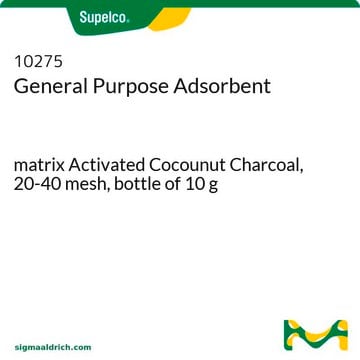Unfortunately, the pore volume is not determined. The surface area by BET is 900 m²/g.
05112
Activated charcoal
suitable for GC
Sinónimos:
Charcoal activated
Seleccione un Tamaño
Seleccione un Tamaño
About This Item
Productos recomendados
presión de vapor
<0.1 mmHg ( 20 °C)
Nivel de calidad
Formulario
granular
temp. de autoignición
842 °F
resistividad
1375 μΩ-cm, 20°C (graphite)
técnicas
LPLC: suitable
gas chromatography (GC): suitable
Matriz
Carbon
grupo activo de la matriz
carbon
tamaño de partícula
0.3-0.5 mm
mp
3550 °C (lit.)
densidad aparente
0.4‑0.5 g/cm3
técnica de separación
reversed phase
cadena SMILES
[C]
InChI
1S/C
Clave InChI
OKTJSMMVPCPJKN-UHFFFAOYSA-N
¿Está buscando productos similares? Visita Guía de comparación de productos
Descripción general
Aplicación
Código de clase de almacenamiento
11 - Combustible Solids
Clase de riesgo para el agua (WGK)
WGK 3
Punto de inflamabilidad (°F)
Not applicable
Punto de inflamabilidad (°C)
Not applicable
Equipo de protección personal
Eyeshields, Gloves, type N95 (US)
Elija entre una de las versiones más recientes:
¿Ya tiene este producto?
Encuentre la documentación para los productos que ha comprado recientemente en la Biblioteca de documentos.
-
What is the typical pore volume for this activated carbon?
1 answer-
Helpful?
-
Active Filters
Nuestro equipo de científicos tiene experiencia en todas las áreas de investigación: Ciencias de la vida, Ciencia de los materiales, Síntesis química, Cromatografía, Analítica y muchas otras.
Póngase en contacto con el Servicio técnico



